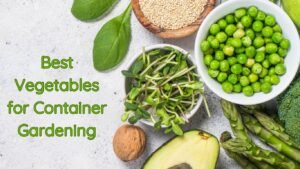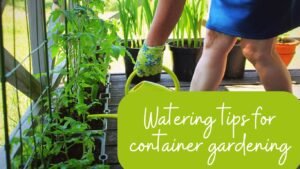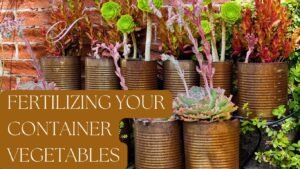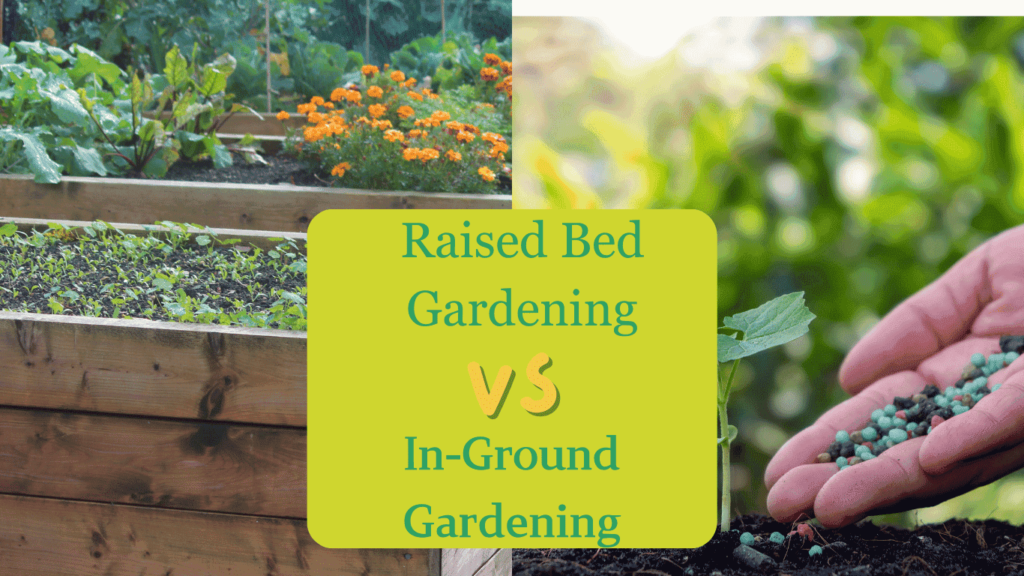Container gardening is one of the best ways to grow vegetables, herbs, flowers, and fruit in small spaces like balconies, in your backyard, or even at your sunny window.
The best thing is that anyone can do container gardening, whether you are an experienced gardener or a beginner.
However, in this article, I am going to teach you everything about growing vegetables, herbs, etc. In containers. Including how you can choose the right size, what type of vegetables you should grow, and what the perfect soil mix for containers is.
And the best spot to place your container, watering tips, fertilization, and much more, which will help you grow a thriving garden.
How to choose the right container for your garden?
First of all, you have to decide what you want to grow. Depending on that, you should decide the container size. For example, tomatoes need a large or deeper container. On the other hand, lettuce can grow in smaller containers.
In a simple world, it totally depends on specific vegetables. For tomatoes, peppers, or eggplants, you can go with a 12 to 16-inch deeper container.
For leafy green vegetables, herbs, or shallow-rooted veggies like lettuce, spinach, and radish, you can go with a small container. 6 to 8 inches deep is okay.
Material options when choosing the right container
There are various types of container materials available, such as plastic, terracotta, and fabric grow bags.
- Plastic containers are lightweight, durable, and budget-friendly. But one thing I don’t like about them is that they heat up quickly in direct sun.
- Terracotta, which is made of clay, is porous, which can help regulate soil moisture. However, they are the opposite of plastic containers. They are heavy and more fragile.
- Fabric grow bags are a great option for excellent airflow and drainage.
However, if I talk about my personal experience, then I have a mix of these materials, but mostly, I have to grow bags because I like them,
Because they don’t heat up too quickly, and the airflow is quite good compared to terracotta or plastic containers.
Don’t forget drainage when you go to the containers
Drainage is very important for container vegetable gardening. Without it, you will risk rot and your plant can face many other issues.
You want to make sure there are drainage holes about 1-2 inches in size in the bottom of your containers. If there is not, you can make it by yourself. You will get it because whenever I bought containers, I got holes in them.
But why do they need to have a hole?
This is because placing a hole in the center of your container will allow excess water to escape.
Tip: You can also fill up the bottom with pebbles or gravel to improve drainage.
Best Vegetables for Container Gardening

Okay, so here are some of the best vegetables, herbs, and fruit that you can consider growing in containers.
I personally grow vegetables on my balcony in containers. I have mentioned most of these vegetables which are generally used in our kitchens.
Top Vegetable Picks:
1. Tomatoes
2. Bell Peppers
3. Cherry Tomatoes
4. Eggplant
5. Zucchini
6. Green Beans
7. Radishes
8. Carrots
9. Leafy Greens (Lettuce, Spinach, Kale)
10. Dwarf or Bush Varieties of Peas
Easy-to-Grow Herbs:
1. Basil
2. Parsley
3. Thyme
4. Rosemary
5. Oregano
6. Mint
7. Chives
8. Cilantro
9. Sage
10. Lavender
Small Fruits:
1. Strawberries
2. Blueberries
3. Raspberries
4. Blackberries
5. Dwarf Citrus (Lemon, Lime, Orange)
6. Dwarf Apple Trees
7. Grapes
You can consider growing what you need the most. I have a small space on my balcony, so I grow vegetables like chilies and tomatoes because we need them the most. We need chilies and tomatoes for almost every recipe.
The perfect soil mix for vegetable container gardening
There are two types of soil: potting soil and garden soil. The main difference between them is that potting soil is formulated for containers or raised beds, while garden soil is good for ground planting.
Also read: Raised Bed Gardening vs. In-Ground Gardening: Which is Better?
Garden soil is good for ground gardening because it’s heavy and dense. So, it can lead to compaction and poor drainage if you use it in pots. On the other hand, the potting mix is lightweight, well-drained, and packed with nutrients.
What oil mix should you use for growing vegetables in containers?
Well, you need a potting mix that contains some important ingredients, such as peat moss or coco coir to retain moisture, perlite or vermiculite to improve aeration and drainage, and compost or any other organic matter to provide nutrients.
If you use all these things, you will create an ideal environment for your garden, which will allow oxygen to reach roots, drain excess water, and feed the plants.
Tips to make soil for container gardening
If you are a DIY gardener, you can easily make your own potting mix. You have to blend equal parts of peat moss or coco coir, compost, and perlite or vermiculite.
Besides this, you can also consider adding a little bit of slow-release organic fertilizer. It will give your vegetables an extra nutrient boost so they can grow a little bit faster and healthier.
Container placement and sunlight
Choosing the right location for your garden is very important for your plant growth and healthy life. So let’s go step by step about sunlight, choosing the right spot, etc.
How much sunlight do vegetables need?
Well, most vegetables and fruits need at least 6 to 8 hours of direct sunlight every day. Vegetables like tomatoes, peppers, eggplant, and cucumber need nearly 8 hours.
On the other hand, if you are growing leafy green herbs or some flowers, they will need less sunlight. 4 to 6 hours of direct sunlight would be okay for them.
How to choose the best spot for containers?
As I have said, sunlight is very important for planting. That’s why you need to place your container in the right place. For example, you can place your container on balconies, patios, or other areas where your plant can get direct sunlight throughout the day.
However, if you don’t have an outdoor space, you can also place it near a sunny windowsill. Just make sure to rotate your container periodically for exposure.
If your space is shady, it sometimes gets direct sunlight, and sometimes it doesn’t. Then, you have to be creative. You have to move the container throughout the day to maximize the sunlight they receive.
What to do if you don’t have direct sunlight?
Well, in that case, if you don’t have access to enough natural sunlight, you can use artificial grow lights indoors. For example, LED or fluorescent light.
However, keep in mind that these types of grow lights cannot stand even closer to direct sunlight or natural light. I myself have never grown my vegetables in grow lights.
You have to understand one thing very clearly: plants need sunlight to make food. I was taught in school that plant make their food through photosynthesis, for which they need air, water, and sunlight. In the end, they are living beings; we can’t fool plants too.
Yes, there are some specific indoor plants that can be grown in a very low environment, but not vegetables and fruits or herbs.
Watering tips for container gardening

Water is very important when you are growing herbs or vegetables in containers. Overwater and underwater both can cause some problems. So let’s know about it.
How often to water your plant and sign of overwatering and underwatering?
The number one thing is how much water you should provide to your plant depends on the size of your container, the type of plant that you are growing, and climate conditions.
It’s a general rule. I have seen my grandfather providing regular water in hot and dry weather, and I myself do it, too.
And in the winter season, we don’t provide regular water. Generally, I look at the soil, or sometimes I touch it. If I see it’s dry, I give it water, especially in the morning and evening. Otherwise, I avoid it.
If you don’t provide enough water to your plant, you can see some signs such as wilting or dropping leaves and crumbly soil; if you provide too much water, you will see stem rot, mushy leaves, etc.
Self-watering containers: what they are, and why they are great beginners
Self-watering containers are good for beginners and for anyone who doesn’t like to give water manually. They are built-in reservoirs that slowly release water to the plant’s roots.
Even if you do travel more often, you can still consider having self-watering containers. Their design takes the guesswork out of watering and ensures your plant is hydrated.
Watering Schedule for Different Vegetables and Climate
For thirsty plants like tomatoes, peppers, and leafy greens, you can provide water every day, especially in hot weather conditions.
For herbs and succulents, you can provide less water because they can grow without water for a few days.
Again, I would say the same thing as I have said before. You have to look at the soil, whether it is moisturized or not. And once you get the clue that it’s getting dry, you can provide water. Otherwise, you shouldn’t.
Fertilizing your container vegetables

Fertilization is very important for growing vegetables, herbs, or anything else.
First of all, you have to understand fertilizer a little more. Liquid fertilizer acts quickly and is easy to apply, but it needs to be applied more frequently.
On the other hand, there is also slow-release granular fertilizer, which provides a steady supply of nutrients over time. And you don’t have to apply this fertilizer frequently.
Organic Fertilizer vs. Synthetic Fertilizer: Which one should you use for a container?
Well, first, you have to understand organic fertilizer a little bit:
Organic fertilizers, like compost, manure, or bone meal, are made from natural resources. And they can improve your soil health over time. But they act more slowly. That’s the only problem with them. Although you can make them for free, using waste from your kitchen.
Synthetic fertilizer is the opposite of organic fertilizer. They act fast and provide an immediate nutrition boost to your plant. But they don’t offer the same long-term soil benefit. Like organic fertilizer.
Recommendation: If you are a beginner, then I would recommend you start with an organic slow-release fertilizer. It is pretty simple to use and will provide a well-balanced nutrition profile for your plant.
I make organic fertilizer at my own home. That’s my personal choice. However, if you are an advanced gardener and your plant is almost dying and you need to fertilize it, then you can go with synthetic fertilizer because it can act fast and provide an immediate nutrition boost.
Otherwise, organic fertilizer is the best option according to me.
Remember that you select a fertilizer that is formulated especially for vegetables and fruits. For that, you can look for the right ratio of nutrients like nitrogen, phosphorus, and potassium. Because most edible plants need these nutrients.
Garden Layout: How to organize your containers
There are many ideas for arranging containers in small spaces. For example, if the space is limited, like me, you are also growing on a balcony, patio, or small yard. You can look up to vertical gardening and companion planting. Let’s understand it:
Vertical gardening is best when you have a small space. You have to utilize vertical space with stackable containers, hanging baskets, or trellises, which will allow you to grow more. So you can also attach your container to the wall or railings.
Companion planting is also an excellent way to grow more vegetables and herbs in the same containers together. For example, you can plant tomatoes with basil or lettuce with radish. Many plants complement each other. So basically, it’s a nice way to utilize a small space and grow more vegetables.
Dealing with Common Container Gardening Problems
I have also faced many problems when I started container gardening. So, let’s know how you can also deal with pests, disease, and drainage-related issues.
How to protect your container plants from common pests
If you are growing plants in containers, you will surely face aphids, caterpillars, and many other pests. However, you can use organic solutions to get rid of them. For example, insecticidal soap and neem oil are great options that can remove aphids, spider mites, and other soft-bodied pests.
Besides this, you can also use insects like ladybugs or lacewings, which can naturally control the aphid population. Moreover, you can also use row covers or screen barriers to block large pests like caterpillars.
Spotting and preventing fungal and bacterial issues
That’s another thing you will face when growing plants in containers. Most of the time, fungal and bacterial diseases can occur because of poor air circulation and overwatering in containers.
Plus, you can also look for signs like powdery, mildew, leaf spot, and wilting. If you see any of these signs, then increase air circulation and decrease water frequency because it might be happening because of providing too much water.
You can also use a fungicide if a disease gets out of your hand. Moreover, you want to disinfect your tools and containers regularly to prevent any pathogens from spreading.
Dealing with poor drainage or root rot
If you ever notice your plant is sitting in water or the soil is too saturated, that’s a clear sign of poor drainage.
First of all, you have to check if your container has holes in it. If there are, it’s okay. Still, you can add a few more holes. Or simply you can enlarge the existing one.
Besides this, you can also elevate your pot on feet or bricks to allow excess water to escape properly.
But, if the rot has already set in, then in this case, you will need to carefully uproot the plant, trim off any damaged rot, and then repot it in fresh and well-draining soil. That’s the only option you can fix.
Harvesting your vegetables

Okay, so after getting a container, taking care of your vegetables, and growing them, now it’s time to harvest them. But before that, we have to know some things about that, like how you know your vegetables are ready.
How to know when your vegetables are ready to harvest?
First of all, the time to harvest your veggies depends on the specific crop. You can look at the size, color, and overall appearance of your product.
For example, if you see that the leaves of your leafy green vegetable are large enough, That means they are ready to pick. While tomatoes should be fully colored. Then, you can harvest them.
I mostly look at the size and color. For example, when I see chilies that are dark green, there is light green, too, but I grow dark green chilies. So when I see they are of normal size and color, I harvest them.
And when I see my tomatoes are large in size, they are red and a little yellowish. I harvest them, too. By the way, I harvest chilies as much as I need. And let other chilies hang on the tree. Even if they turn red, they still taste the same. Spicy.
Tips for continuous harvesting
Many vegetables like lettuce, spinach, and herbs can be harvested multiple times through a technique that we call “cut and come again.”
If you want to follow this technique, you first simply have to snip off the outer leaves or stems, leaving the plant’s center intact. It will encourage more growth and a steady supply.
Store and enjoy your homegrown produce
Once you have harvested, make sure to properly store your homegrown vegetables to maximize freshness. Many vegetables like tomatoes, peppers, and leafy greens will stay fresh for around 3-5 days in a refrigerator.
By the way, the best way to enjoy your harvest is to eat it right away. I mostly don’t grow the same vegetables or fruits. I grow different plants at different times so that I don’t have to harvest them all together.
Meaning I don’t grow four tomato plants altogether. I grow one and then a second one after one week, and another one after the next week so that they all don’t get ready to harvest at the same time.
Container gardening year-round
Well, it is nice to extend the growing season with container gardening, especially if you have a colder climate.
How to extend the growing season with cold-tolerant vegetables?
Well, there are many vegetables that can thrive well in cooler temperatures. For example, if we talk about leafy greens, then you can grow spinach, kale, and Swiss chard. And if we talk about root vegetables, then you can grow carrots, beets, and radishes.
Besides this, you can also grow brassicas like broccoli, Brussels sprouts, and cabbage. You have to select any of these cold-environment growing varieties.
Indoor Container Gardening Tips for the Colder Month
In the winter season, outdoor gardening is quite challenging. However, you can continue to cultivate indoor containers. First, you have to choose compact, shade-tolerant plants like herbs, micro greens, or small-scale veggies. After that, you have to place them on a sunny windowsill or under grow lights.
Setup a simple greenhouse or cold frame for winter gardening
If you have a container outdoors, then you can set up a simple greenhouse or cold frame structure. This will help insulate your plant and protect it from harsh weather. Besides this, you have to focus on growing cold-tolerant crops like lettuce and radish.
FAQ about container gardening
Here are some related questions that people have asked about container gardening, and they might be helpful for you to know.
What kind of soil is best for growing vegetables in container
The best soil for growing veggies and herbs in containers is a high-quality potting mix, which is specifically formulated for containers. You shouldn’t use garden soil in containers because it’s too compacted in the confines of containers.
A high-quality potting mix is light and well-drained, plus enriched with organic matter, which can provide all necessary nutrients like potassium to your plant.
How deep should containers be for root vegetables?
Root vegetables like carrots, radishes, and beets need deeper containers because they have longer roots. You can have a minimum depth of around 12 inches, but it is still better if the depth is around 14 to 16 inches because 14 to 16-inch depth will give the root enough room to develop properly.
Can I grow vegetables indoors in containers?
Of course, you can grow vegetables indoors in containers. Many vegetables can thrive well. You just have to provide them with the right conditions. Besides this, you will also want to choose compact, bush-type varieties that don’t need too much space. For example, cherry tomatoes, dwarf bok choy, baby carrots, etc.

